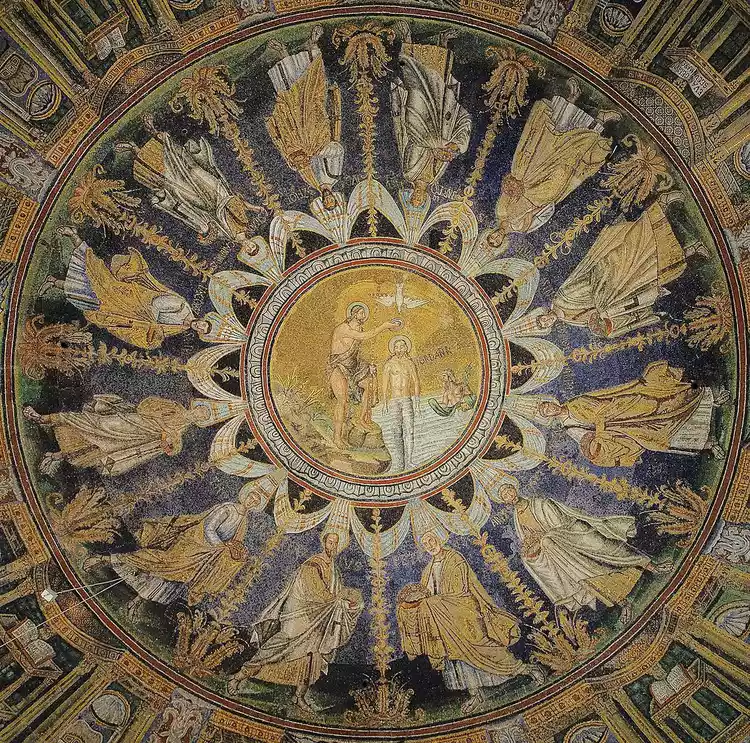Summary
Ravenna is known as the city of mosaics due to the breathtaking 5th- and 6th-century mosaics that embellish its churches and monuments. Consequently, it continues to be one of Italy’s premier mosaic producers. Ravenna boasts eight UNESCO World Heritage Sites, along with numerous Roman sites, museums, Dante’s tomb, and a famous summer music festival. Moreover, the historic center is a compact, flat pedestrian zone, making it ideal for exploration.
Ravenna History
Ravenna was a prominent Roman city from the fifth to the eighth centuries, serving as the western capital of the Roman Empire and the Byzantine Empire in Europe. Initially a lagoon city, its canals were filled in during the 15th century when Venice ruled Ravenna. The elegant central square, Piazza del Popolo, emerged during this period. In the 1700s, a new canal was constructed, reconnecting Ravenna to the sea.
Ravenna’s UNESCO World Heritage Sites
Ravenna’s remarkable monuments and churches from the 5th-6th centuries are recognized as UNESCO World Heritage Sites, primarily due to their magnificent early Christian mosaics.
- Basilica di San Vitale: This basilica is one of Italy’s most significant monuments of early Christian art, featuring an elegant cupola and stunning 6th-century mosaics in its apse.
- Mausoleo di Galla Placidia: Built in the mid-fifth century, this mausoleum showcases breathtaking mosaics, some of the oldest in the city.
- Battistero degli Ortodossi: The oldest monument in Ravenna, this baptistery was constructed in the late fourth to early fifth centuries and features spectacular mosaics decorating the dome.
- Battistero degli Ariani: This baptistery is one of the few surviving monuments of the Arian cult with beautiful dome mosaics.
- Basilica di Sant’Apollinare Nuovo: Originally a Palatine church, this basilica has Byzantine mosaics that reflect both early-Catholic and Arian beliefs.
- Chapel of Sant’Andrea: A private chapel populated with mosaics of flowers, figures of Christ, and various bird species.
- Mausoleo di Teodorico: Constructed in 520AD for the king of the Ostrogoths, this tomb, made of Istria stone, is unique for lacking mosaics but features stunning friezes.
- Basilica of Sant’Appolinare in Classe: Located outside Ravenna in the ancient Roman port of Classe, its apse is adorned with mosaics.
Roman Sites in Ravenna
- Domus dei Tappetti di Pietra: Known as the House of Stone Carpets, this site beneath the Church of S. Eufemia exhibits remarkably preserved 5th-6th century mosaic floors.
- Classe Archaeological Park: Established by Emperor Augustus, this ancient port city continues to reveal new archaeological findings through ongoing excavations.
Ravenna Museums
- National Museum: Housed in the ex-Benedictine Monastery of San Vitale, it features a rich collection of Roman and Byzantine artifacts.
- M.A.R.: The Municipal Art Museum showcases contemporary mosaics, medieval and modern art, alongside temporary exhibitions.
- Museo Arcivescovile: This cathedral museum showcases the Chapel of Sant’Andrea and the remarkable ivory throne of Maximian, crafted by sixth-century artisans.
- Dante Museum: Dedicated to Dante Alighieri, this museum includes significant works and houses his tomb built in 1780.
- Basilica of San Francesco: With a unique feature of a water-filled crypt, this basilica has historical significance, including hosting Dante’s funeral.
Combination Ticket
A complicated combined ticket scheme allows access to five of the city’s most renowned sites over a period of seven days. However, other churches and sites require individual tickets, with some being free of charge.
Cultural Events in Ravenna
- Alighieri and Rasi Theaters: Offering music, ballet, and theater performances regularly.
- Ravenna Festival: An exciting summer event featuring opera, concerts, dance performances, cinema, and exhibitions.
- Mosaico di Notte: This evening event occurs Monday through Friday from June to September, featuring night tours and guided tours starting at the Domus dei Tappetti.
- Antiques Market: Held on the third weekend of every month, showcasing local antiques and crafts.
Ravenna Location and Transportation
Situated in the Emilia Romagna region of northeastern Italy, Ravenna is approximately six km from the A14 highway and around 80 km from Bologna. It is accessible via direct train connections from Bologna, Faenza, Ferrara, and Rimini along the coast.





